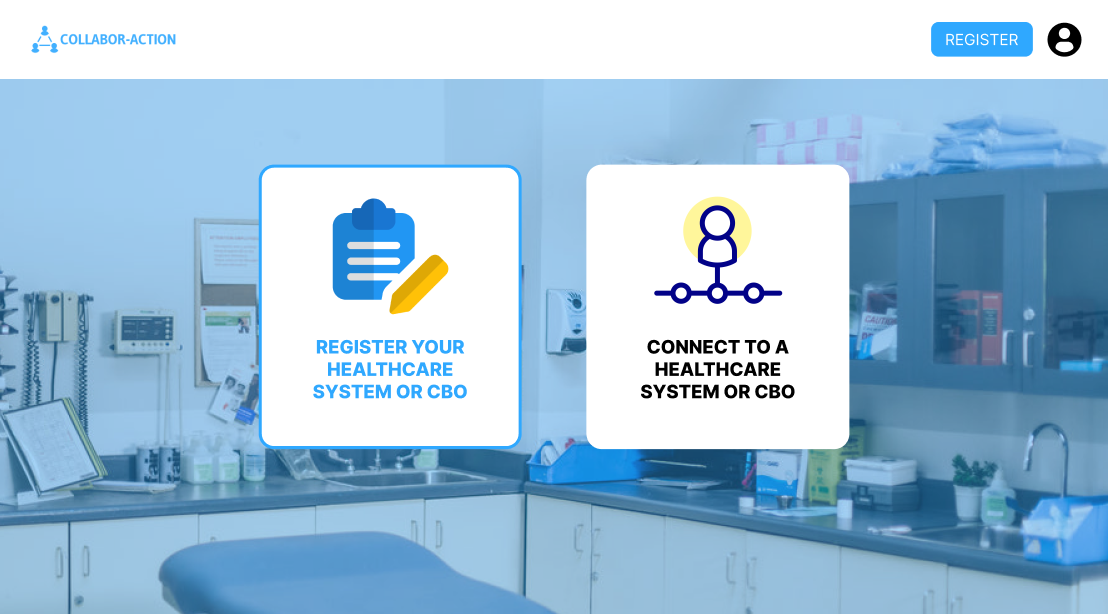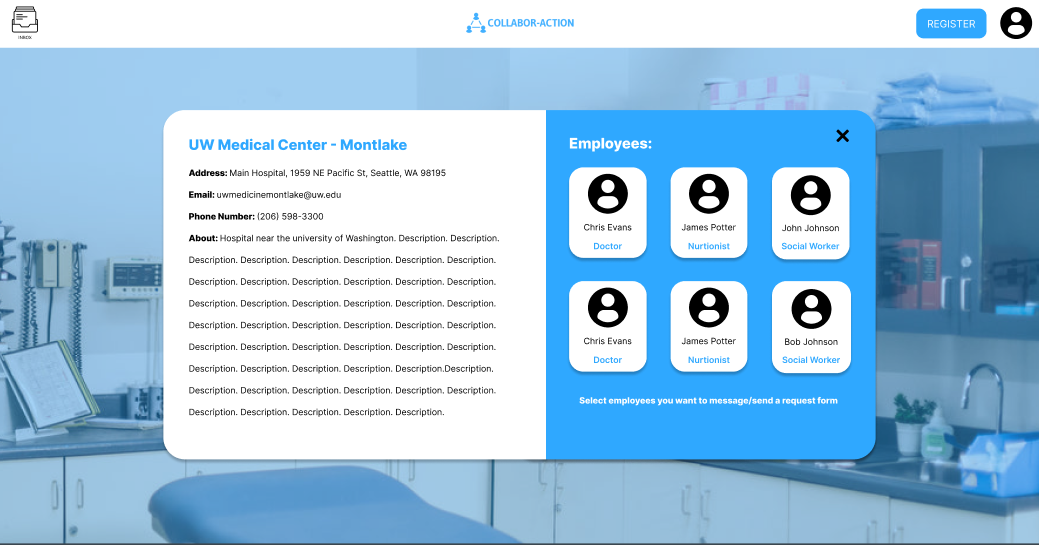Anas Azeemi
Software Developer
Vincent Chen
Project Manager
Chris Kim
Software Developer
Saeid Mohamed
Software Developer
Jonathan Trinh
UX Designer
The Team
Problem Context
What is Collabor-Action?
Collabor-Action is a web-browser platform tool designed to streamline and improve the efficiency of cross-partnership between community-based nonprofit organizations (CBOs) and healthcare systems. This tool was my group’s capstone project and was developed over the course of 2 quarters (over 20 weeks) at the University of Washington. We initially started with the idea of doing something related to the topic of non-profit organizations. Then our professor said it was important to narrow the scope, to which we responded by diving into the world of CBOs and their aid towards the world, specifically healthcare systems.
From our interest in the topic, much of our initial research led to our group discovering the following problems shared within the concept of effective and efficient collaboration between CBOs and Healthcare systems:
Community-based care coordination is fragmented, under-resourced, and has gaps
WA state is under pressure to reach healthcare milestones for funding packages
Workforce shortages are a top challenge for healthcare systems to reach underserved communities
This leads to our problem statement below…
How might hospital systems achieve efficient and informative collaborations with Community-Based Organizations (CBOs), so that they can optimize their speed and outreach of care-based services to promote community health?
Problem Statement
Research
We took our problem statement and dived into deep research about regarding the question. We engaged in market research, literature review and initial user research, gaining a variety of insight that we wanted to keep in mind before we engaged in ideation for our capstone project’s final MVP (minimally viable product).
Market Research:
We first started by looking at current products that indirectly or directly relate to our group’s problem statement. We gathered and analyzed 25 different products including:
Clinical Documentation Guide 4+ Optum Inc.
GoCanvas
Hivebrite
Tribe
Evergreen Health
Klara
MyChart
Zendesk For Service
NexHealth
Connect.software
Connect Kindness
Cartogram
Health Leads
NowPow
Unite Us
Literature Reviews:
Give Lively
Get Real health
Social Solutions
Contexture
DeterminedHealth
Community Funded
Community Connexor
Alliance1
WellSky
From these products, we gained the following insight that we want to incorporate into our product MVP (minimally viable product) and future iterations
As we looked into different products, we also engaged in a literature review. My group and I analyzed over 20 different documents (website, policies, etc…) and found the following insights that educate us on how we can help through our product:
Strong communication & planning is crucial in the absence of resources
Washington State is under pressure to reach healthcare milestones for funding packages
Clear communication is needed between both CBOs and healthcare systems
The partnership between Health Care systems & CBOs promotes community health outreach efforts
Lack of resource/resource management
The need for accessible resources found in CBOs is high due to the lack of policies toward publicly accessible care
Marginalized communities need the most help
CBOs want to identify relevant partnerships
Conducting evaluations to measure performance & outreach efforts is crucial for understanding the efficacy of partnerships
Initial User Research:
We tried to contact a variety of intended users via email, phone calls, and in person. I personally spent over an hour leaving voicemails and emails to get a few responses back to start our interview. We tried to contact those who would be responsible for the coordination between CBOs and Healthcare systems, such as CBO representatives, hospital's non-profit coordinators, and social workers. After we conducted our interviews we were left with the following notes and key insights:
User Cases
The following user cases help us further think about the mindset of our users, establishing some of the challenges both parties of users might encounter that our product can help solve.
These user cases, along with our research, enabled us to better understand what our intended users needed, learning what are some of the major issues related to our problem in detail, and think about how we can solve those problems with our product. From these insights, we wanted to concentrate on specific design principles and have a clear set of key features to prioritize time management and the successful timely completion of our group’s MVP. We then will dive into the ideation phase and soon have various iterations of our product over the course of 2 quarters.
Ideation
During our ideation phase we a had a variety of features in mind, developing a list of our P0, P1, and P2 features. In the end, we decided to focus on 3 key features:
Organization and Employee Registration
Dashboard / Information Cards
Message Form / Inbox
We chose these 3 features to focus on because we wanted our final MVP to be able to achieve our mission of helping both healthcare systems and CBOs become a part of a system that enables feasible research and discovery and promotes clear communication and asks for aid from one another. Our registration system enables organizations to join a cooperative movement between CBOS and healthcare systems and allows individuals to join in clear communication opportunities between organizations. The dashboard and information cards inform users of the purpose of the website, allow for the discovery of organizations, and enable the transition from discovery to communication. The message from an inbox page enables clear communication to occur, increases awareness of whom receives messages, and provides opportunities for cross-sector partnerships.
Iteration
Iteration 1:
In the first iteration, our group had initially solely focused on enabling discovery and registration within our system. We did this to prioritize time management, while still thinking that our solution could help solve the issues we found. Our main page requires users to scroll down to learn more about the product and why we built it. In addition, they would search for companies on the homepage at which when they found the company they are looking for, they can click and access that organization’s information card and learn about them and how to contact them.
Users can register their company to be a part of the system. They would click on the register button in the top right corner to access the registration options page (shown below). After selecting the “register your healthcare system or cbo” button, users will fill out the information that will be added to their company’s information card. Users can also register themselves as an employee of an organization in the system using the “connect to a healthcare system or CBO” button. This will lead users to a page where they will fill out an form that will enable them to edit their company’s information card
Iteration 2:
After receiving feedback from our first iterations, we decided to create a centralized homepage, allowing users to see all the details about Collabor-Action, having an almost dashboard-like appearance. Users will still be able to search for organizations, but instead of remaining on the homepage, users will be taken to a different page devoted to a single information card, Users can see details in regards to an organization’s location, contact information, an about section for the organization, and those who work at the company and are registered in the Collabor-Action user database to be able to edit their companies information card.
During this second iteration, it was pointed out that our product needed a communication system in order to actually solve the issues we saw in our research. Without the communication system, our ideal solution could easily be replaced by accessible tools, like Google. The communication system would enable our product to become a centralized platform that can serve better than other tools, such as Google, by being a reliable source when it comes to communication and collaboration between CBOs and healthcare systems. Within our second iteration, users can click on employee icons on information cards in order to select and send a message to those individuals asking for help or for future collaborations. Users will fill out a form that will be sent to those selected employees. Users can view their messages in their inbox page by clicking on the inbox icon in the corner of the top navigation bar.
Iteration 3:
After the second iteration, we engage in user interviews with direct stakeholders and were primarily given good feedback in regard to the design of the web-browser platform. They provided feedback in regards to how certain text highlighted in blue on the page was initially thought of as links. In addition, they collectively described how there is a high amount of turnover within the hospital system among employees and that there would be primarily one or two employees who would be responsible for the coordination between organizations. In addition, stakeholders suggested adding a list of services organizations provide to allow users to learn better about an organization when looking over information cards. Furthermore, we were informed there are organizations that are both a healthcare system and a CBO, so our registration forms. Below you will be able to see the minor changes that we discussed and redesigns to help provide clarity to our project.
Before
After
Demo Video:
Reflection
Although we as a group chose not to continue developing the product after our final submission, we left the GitHub repository and general project open to the public and for future capstone teams who would want to pick up our project from where we left off. When looking back on the project and thinking about giving advice to whoever chooses to pick up this project, there were a variety of features we could have better implemented within the timeframe we were given. We would want to develop:
Survey to assess the capabilities, strengths, and weaknesses of CBOs & healthcare systems
Ability to share possible collaborative events
Allowing each organization to choose 3-5 tags to describe themselves & be sorted accordingly
These features would enable better connectivity and organization within our platform’s database and would increase the feasibility for organizations to research and find specific organizations to collaborate with or get help from. In general, I believe the project to be somewhat successful, enabling my group to better understand the MVP development life cycle and be more prepared towards implementing similar tactics and our skill sets for future projects.































